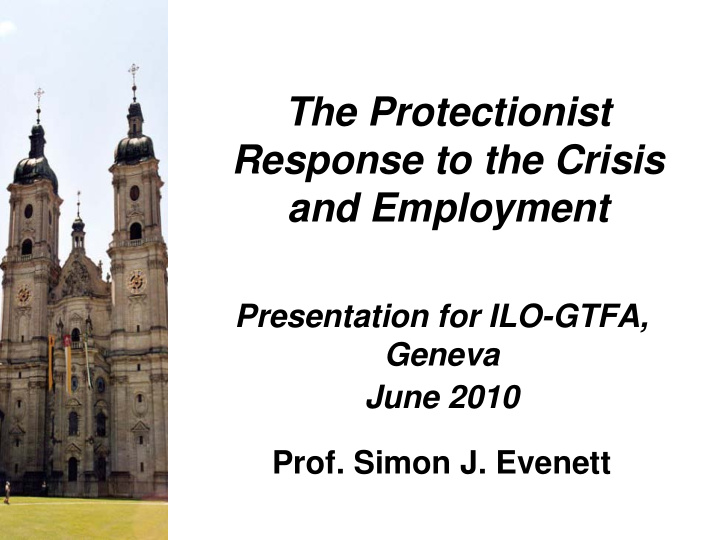



The Protectionist Response to the Crisis and Employment Presentation for ILO-GTFA, Geneva June 2010 Prof. Simon J. Evenett
Purpose of this presentation • Given the nature and prevalence of beggar-thy-neighbour measures taken during the crisis, what are the implications for employment conditions? • Summarise main findings of the Global Trade Alert (sixth report to be published on Wednesday, see www.voxeu.org and www.globaltradealert.org) • Rational crisis-era policy responses: a case study of the Russian automobile industry. 2
Measures implemented since first crisis-related G20 summit in November 2008, totals for all jurisdictions and change since last G20 summit. This report Increase from previous G20 meeting (2 nd GTA report) (June 2010) Statistic Total except unfair Total except unfair Total trade and safeguards Total trade and safeguards investigations investigations Total number of measures in GTA 775 609 495 378 database Total number of 135 108 95 72 measures coded green Total number of measures coded 91 61 43 31 amber Total number of 554 443 357 275 measures coded red 3
Q4 2009 and Q1 2010 are on track to match the same protectionist pace as the first half of 2009, when concerns about protectionism were at their highest. 4
The record for 2009 now looks much worse than it did at the last G20 meeting; documenting "murky protectionism" takes time. 5
Nearly 650 harmful measures, taken since the G-20 Leaders' summit in November 2008, remain; there is much crisis-era protectionism to unwind. 6
Who has caused most harm? Rank Metric, Country in specified rank, Number Ranked by number of Ranked by the Ranked by the Ranked by the (almost certainly) number of tariff lines number of sectors number of trading discriminatory measures (product categories) affected by (almost partners affected by imposed affected by (almost certainly) (almost certainly) certainly) discriminatory discriminatory discriminatory measures measures measures 1 EU27 (146) Venezuela (784) EU27 (55) EU27 (168) 2 Russian Federation (73) Kazakhstan (719) Algeria (54) Argentina (161) 3 Argentina (41) Nigeria (599) Nigeria (45) China (161) 4 India (31) EU27 (437) Venezuela (38) Indonesia (152) 5 Germany (29) Russian Federation Kazakhstan (36) Russian Federation (421) (142) 6 UK (24) India (347) Russian Federation Indonesia (347) (34) Finland (132) 7 Indonesia (22) Ethiopia (32) Germany (132) 8 China (19) Ethiopia (345) Indonesia (32) South Africa (132) 7 9 Italy (19) Argentina (336) India (31) Belgium (131) 10 Austria (17) China (335) Germany (27) Brazil (131)
Top 10 most used measures Number of discriminatory (red) measures imposed. Increase from previous State measure G20 meeting This report (June 2010) (2 nd GTA report) Bail out / state aid measure 183 121 Trade defence measure (AD, 112 84 CVD, safeguard) Tariff measure 75 44 Export taxes or restriction 31 25 Public procurement 28 16 Non tariff barrier (not 26 15 otherwise specified) Migration measure 24 17 Export subsidy 19 10 Import ban 16 10 8 Local content requirement 15 na
Top 10 most affected sectors Number of discriminatory (red) measures CPC code, Affected Sector affecting commercial interests in this sector 81 ( Financial intermediation services and auxiliary services therefor) 74 41 ( Basic metals) 66 49 ( Transport equipment) 63 44 ( Special purpose machinery) 56 01 ( Products of agriculture, horticulture and market gardening) 54 34 ( Basic chemicals) 49 42 ( Fabricated metal products, except machinery and equipment) 46 21 ( Meat, fish, fruit, vegetables, oils and fats) 45 23 ( Grain mill products, starches and starch products; other food products) 41 9 02 ( Live animals and animal products) 39
China is the only developing country among the Top 10 targets Number of discriminatory measures imposed on target Top 10 Targets Increase from previous G20 This report meeting (June 2010) (2 nd GTA report) 282 183 China 266 na EU27 213 127 USA 204 120 Germany 188 110 France 181 109 UK 175 105 Italy 170 92 Belgium 168 90 Japan 163 92 Netherlands 10
Impact on LDCs • Data can be extracted directly from GTA website. • Number of benign or liberalising measures benefiting LDC exports: 31 • Number of harmful measures facing LDC exports: 94 • Number of pending harmful measures: 19 • Number of jurisdictions responsible for harmful measures: 60 . • Top 3 harmful measures imposed on LDCs: – Bailouts and state aids (26) – Tariff measures (23) – Export taxes and restrictions (22). 11
Rational policy choice? The case of Russian Automobiles • See Gerasimenko (2010) case study in the forthcoming (6 th ) GTA report. • Light car industry suffered 33 protectionist measures, half imposed by Russia. • Average value of subsidy support per car in 2009: 138,258 roubles (US$4,600). – In 2010 average support expected to rise to 197,000 roubles (US$6,500). • NB: Annual average salary of workers: US$6,000. • On top of this tariff increases have already led to price rises of 33 percent on domestic cars. • Domestic sales continue to fall, imports fall faster. 12
Recommend
More recommend